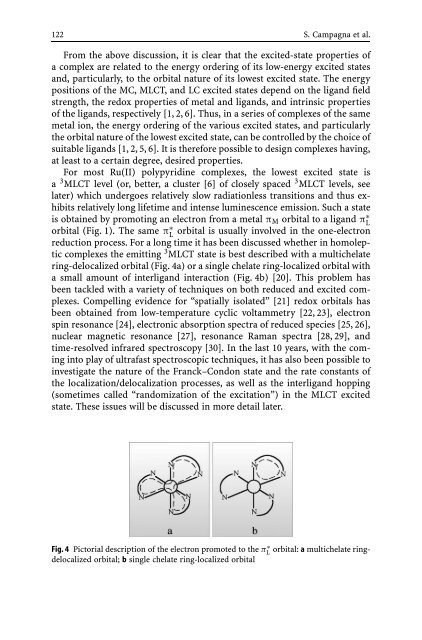Photochemistry and Photophysics of Coordination Compounds
Photochemistry and Photophysics of Coordination Compounds
Photochemistry and Photophysics of Coordination Compounds
Create successful ePaper yourself
Turn your PDF publications into a flip-book with our unique Google optimized e-Paper software.
122 S. Campagna et al.<br />
From the above discussion, it is clear that the excited-state properties <strong>of</strong><br />
a complex are related to the energy ordering <strong>of</strong> its low-energy excited states<br />
<strong>and</strong>, particularly, to the orbital nature <strong>of</strong> its lowest excited state. The energy<br />
positions <strong>of</strong> the MC, MLCT, <strong>and</strong> LC excited states depend on the lig<strong>and</strong> field<br />
strength, the redox properties <strong>of</strong> metal <strong>and</strong> lig<strong>and</strong>s, <strong>and</strong> intrinsic properties<br />
<strong>of</strong> the lig<strong>and</strong>s, respectively [1, 2, 6]. Thus, in a series <strong>of</strong> complexes <strong>of</strong> the same<br />
metal ion, the energy ordering <strong>of</strong> the various excited states, <strong>and</strong> particularly<br />
the orbital nature <strong>of</strong> the lowest excited state, can be controlled by the choice <strong>of</strong><br />
suitable lig<strong>and</strong>s [1, 2, 5, 6]. It is therefore possible to design complexes having,<br />
at least to a certain degree, desired properties.<br />
For most Ru(II) polypyridine complexes, the lowest excited state is<br />
a 3 MLCT level (or, better, a cluster [6] <strong>of</strong> closely spaced 3 MLCT levels, see<br />
later) which undergoes relatively slow radiationless transitions <strong>and</strong> thus exhibits<br />
relatively long lifetime <strong>and</strong> intense luminescence emission. Such a state<br />
is obtained by promoting an electron from a metal πM orbital to a lig<strong>and</strong> π∗ L<br />
orbital (Fig. 1). The same π∗ L orbital is usually involved in the one-electron<br />
reduction process. For a long time it has been discussed whether in homoleptic<br />
complexes the emitting 3 MLCT state is best described with a multichelate<br />
ring-delocalized orbital (Fig. 4a) or a single chelate ring-localized orbital with<br />
a small amount <strong>of</strong> interlig<strong>and</strong> interaction (Fig. 4b) [20]. This problem has<br />
been tackled with a variety <strong>of</strong> techniques on both reduced <strong>and</strong> excited complexes.<br />
Compelling evidence for “spatially isolated” [21] redox orbitals has<br />
been obtained from low-temperature cyclic voltammetry [22, 23], electron<br />
spin resonance [24], electronic absorption spectra <strong>of</strong> reduced species [25, 26],<br />
nuclear magnetic resonance [27], resonance Raman spectra [28, 29], <strong>and</strong><br />
time-resolved infrared spectroscopy [30]. In the last 10 years, with the coming<br />
into play <strong>of</strong> ultrafast spectroscopic techniques, it has also been possible to<br />
investigate the nature <strong>of</strong> the Franck–Condon state <strong>and</strong> the rate constants <strong>of</strong><br />
the localization/delocalization processes, as well as the interlig<strong>and</strong> hopping<br />
(sometimes called “r<strong>and</strong>omization <strong>of</strong> the excitation”) in the MLCT excited<br />
state. These issues will be discussed in more detail later.<br />
Fig. 4 Pictorial description <strong>of</strong> the electron promoted to the π ∗ L<br />
delocalized orbital; b single chelate ring-localized orbital<br />
orbital: a multichelate ring

















